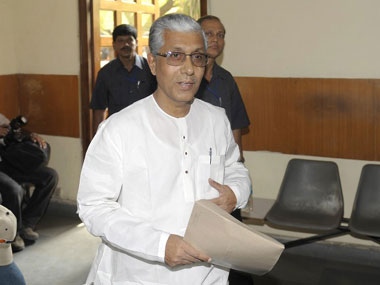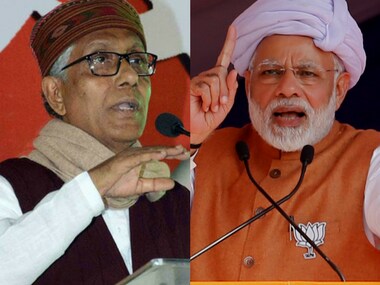When Mamata Banerjee’s Trinamool Congress uprooted the Left Front government from West Bengal in 2011, columnist Mukul Kesavan wrote a piece hoping the communists would survive the spell in exile from office. He counted some attributes of the Left that he thought were exemplary, including providing an alternative to the ideas that Bharatiya Janata Party and Congress represented, giving regional players their due in the federal politics and stamping out riots in West Bengal. The state had been historically quite prone to it.
But none of these attributes were ostensibly more inspiring than the inherent decency of the Left’s national leaders. Kesavan spoke of a woman who was disinterested in the "minutiae of Left politics", but who was also emphatic that the only decent parliamentarians who came on television belonged to the Left — Indrajit Gupta, Somnath Chatterjee and Sitaram Yechury. As proof, she told Kesavan, "They’re the only ones I would trust in the same room as my daughter."

File image of Manik Sarkar. AFP
Given the battering that the Left has received in Tripura, the chances of communists coming to the Centre as parliamentarians and improving the decency quotient of the Indian political class continue to nosedive. Obviously, this has little to do with Tripura, which, after all, elects only two Lok Sabha MPs and sends one to the Rajya Sabha.
Yet the defeat in Tripura is significant because it is here that India witnessed for the first time a direct contest between the Left and the Right of Indian politics. And the Left was pushed to a distant second. It is nowhere near the sniffing distance of power in West Bengal. It has lost many pockets of influence it had in states like Bihar, Uttar Pradesh, Rajasthan, etc. The red flag flies only in Kerala, where power shifts from the Left-led Front to the Congress-led alliance every five years.
The Left’s loss of Tripura means it will face a stiff challenge from the Rashtriya Swayamsevak Sangh, whose cadres continue to grow with every electoral victory as does its mammoth financial resources. Kerala is indeed the Left’s only redoubt, for it finds difficult to stage a comeback wherever it has declined, whether in West Bengal or in its pockets of influence that once dotted India’s political terrain.
Is it then the time to write the Left’s obituary?
Everybody’s favourite counter-argument would be that BJP had slipped to just two seats in the Lok Sabha in 1984, but commands a majority of its own today. It might, after the 2019 General Elections to Lok Sabha, even become India’s natural party of governance, just as Congress was until 1989.
But the Left can’t be the BJP for a variety of reasons, none more than the fact that it won’t opt for communal polarisation, which unmistakably shines through the ideological camouflage of Hindutva. Nor does it have leaders who can emerge out of the ideological straitjacket to create for themselves the communist equivalent of, say, the Ram Janmabhoomi movement, which is what propelled BJP from the margins of Indian politics to its very centre.
Certainly, the Left had its chances to create symbols through which it could have captured the national imagination. In hindsight, it does seem CPM committed an egregious mistake in disallowing Jyoti Basu to head the United Front coalition government in 1996. Boxed in Kerala, West Bengal, and Tripura, Basu as prime minister could have helped the Left to break into new areas through a formulation of radical economic policies.
However, CPM reasoned that a coalition of a medley of parties was intrinsically unmanageable and bound to collapse in due course. The consequences of such an eventuality, the party feared, could prove disastrous for its support base in its bastions. So, between playing safe and being a little adventurous, the Left chose caution, postponing expansion through the ballot to one that was to be achieved through a mass movement, for which they had anyway lost appetite because of being in power for well over a decade.
The Left compounded this mistake by pulling support from the UPA government of Manmohan Singh on the issue of India signing a nuclear deal with the United States. Neither the UPA government fell nor was the nuclear deal stalled. Might it not have been a better idea to pull the plug from the UPA government on its neo-liberal economic policies against which it railed?
The architect of both these mistakes was CPM’s former general secretary, Prakash Karat, whose intellectual heft and obsession with ideological clarity, aka rigidity, impresses most. It has now led him to oppose CPM general secretary Sitaram Yechury’s line that the Left should build alliances with Congress and other regional parties before the 2019 elections.
Karat’s line seems a prescription for the Left to inflict a fresh wound on itself. A BJP victory in 2019 will certainly lead to the Left’s fort of Kerala being besieged and the secular democratic space shrinking. It is no longer an issue of the Left growing in the distant future; rather, it is about the Left surviving to fight another day.
True, the Left can’t walk into a new dawn on the crutches of allies. But does it boast an array of leaders who can rebuild the party by initiating a mass movement, the surest route to achieve success, that is durable?
This is precisely where Kesavan’s decent men are found wanting. Or it can be said that their decency is a bit hypocritical. In an insightful piece in The Hindu, academician Pulapre Balakrishnan points to the irony of decent men leading a party whose activists are engaged in a bloody tit-for-tat with other formations, including RSS, which too has violence coded into its DNA. From Balakrishnan’s analysis, it would seem the decency of Left national leaders is a structural hypocrisy.
As Balakrishnan says, “In almost all cases the actual killing is undertaken by young men of the working classes while the leadership rests with a class that does not soil its hands with labour of any kind. At the national level, the so-called intellectuals lead CPM while its rank and file are of the subaltern class. It is members of this underclass that cannot hope to ever lead the party who find themselves in the frontline of the assault against opponents named 'class enemies’."
The structural hypocrisy of Left leaders, in a way, limits the expansion of their movement. It isn’t a problem of recent vintage. Back in the 1940s and 1950s, the communists were abusive towards Dr BR Ambedkar and dubbed him casteists. They sincerely believed that Ambedkar’s caste movement would drive a wedge in the unity of the working class, pit the upper castes against those lower to them in the hierarchy. They also assumed, rather naively, that a classless society will automatically lead to the obliteration of caste discrimination and exclusion.
It led to the splitting of caste and class movements in India. Obviously, the Left has belatedly realised its folly. It now seeks to unite the Dalits and the Left. But such is the legacy of animosity that the sight of Dalit leader Jignesh Mevani sharing the platform with the Left youth leaders arouses suspicion among Dalits, evident from this writer’s piece.
A large segment of Dalits believes the Left wants to co-opt them and revive its flagging fortunes through their support. They perceive the Left as a party of upper caste leaders, whose intentions are suspicious, is no different from those of BJP and Congress.
The Left, therefore, needs to reflect in its leadership structure the subaltern groups whom they claim to represent. They may not conform to the idea of the typical middle-class decent folks but can be depended upon to soil their feet by participating in a grassroots movement.
The limitation of Kesavan’s decent leaders is palpable in West Bengal. After the Left was voted out in 2011, its middle-rung leaders simply switched over to the Trinamool Congress. Fattened on the state government’s largesse, largely because it was through these middle-level leaders that the state provided its services, they just didn’t want their money-making methods to end. These leaders are in the forefront of combating Left cadres who still remain ideologically committed, preventing them from even opening offices in rural Bengal.
It is hard to see how decent communist leaders will wade into such territories. Once they identified with the poor, lived with them, took up their cause, but they gradually junked the method as their hold over the levers of power strengthened. Years in power have perhaps left them with no stomach for a fight without the state’s protective shield.
Nobody would want Left leaders to become like heads of other political parties, as much known for their venality as their murderous ways. Still, the Left needs to ensure that its leadership structure includes representatives of the groups on whose behalf they claim to fight, whether or not they are the paragon of middle-class decency, sophistication and intellectualism. It is they who can possibly create the communist equivalent of the Ram Janmabhoomi movement.
Published Date: Mar 04, 2018 14:18 PM | Updated Date: Mar 04, 2018 14:18 PM


